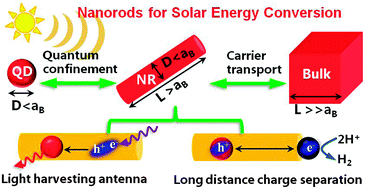Quantum confined colloidal nanorod heterostructures for solar-to-fuel conversion
Abstract
Solar energy conversion, particularly solar-driven chemical fuel formation, has been intensely studied in the past decades as a potential approach for renewable energy generation. Efficient solar-to-fuel conversion requires artificial photosynthetic systems with strong light absorption, long-lived charge separation and efficient catalysis. Colloidal quantum confined nanoheterostructures have emerged as promising materials for this application because of the ability to tailor their properties through size, shape and composition. In particular, colloidal one-dimensional (1D) semiconductor nanorods (NRs) offer the opportunity to simultaneously maintain quantum confinement in radial dimensions for tunable light absorptions and bulk like carrier transport in the axial direction for long-distance charge separations. In addition, the versatile chemistry of colloidal NRs enables the formation of semiconductor heterojunctions (such as CdSe/CdS dot-in-rod NRs) to separate photogenerated electron–hole pairs and deposition of metallic domains to accept charges and catalyze redox reactions. In this review, we summarize research progress on colloidal NR heterostructures and their applications for solar energy conversion, emphasizing mechanistic insights into the working principle of these systems gained from spectroscopic studies. Following a brief overview of synthesis of various NRs and heterostructures, we introduce their electronic structures and dynamics of exciton and carrier transport and interfacial transfer. We discuss how these exciton and carrier dynamics are controlled by their structures and provide key mechanistic understanding on their photocatalytic performance, including the photo-reduction of a redox mediator (methyl viologen) and light driven H2 generation. We discuss the solar-driven H2 generation mechanism, key efficiency limiting steps, and potential approaches for rational improvement in semiconductor NR/metal heterostructures (such as Pt tipped CdSe@CdS dot-in-rod NRs). Finally, we conclude by pointing out challenges to be addressed in future research.


 Please wait while we load your content...
Please wait while we load your content...